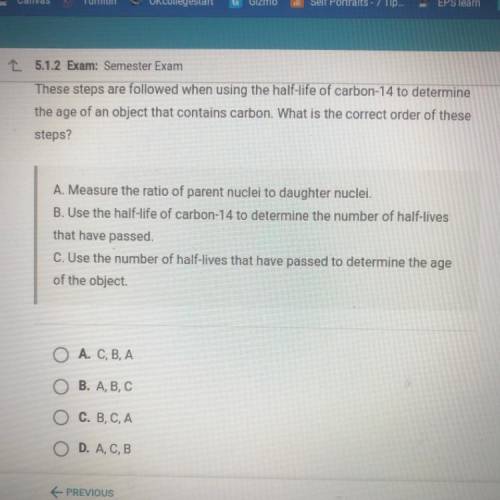
These steps are followed when using the half-life of carbon-14 to determine
the age of an object that contains carbon. What is the correct order of these
steps?
A. Measure the ratio of parent nuclei to daughter nuclei.
B. Use the half-life of carbon-14 to determine the number of half-lives
that have passed
C. Use the number of half-lives that have passed to determine the age
of the object.


Answers: 1


Another question on Physics

Physics, 21.06.2019 17:10
The “death throes” of stars are amongst the most complex phenomena in all of astronomy, and the “corpses” of stars amongst the most energetic and exotic objects in existence. beginning at the end of the core helium fusion stage in a star’s life, describe in detail the post-main sequence development of both (a) a 1.0 solar mass star, and (b) a 25.0 solar mass star. in what significant ways do they differ? what role does each of these types of stars play in the "star-gas-star" cycle and the evolution of chemical elements in our galaxy?
Answers: 1

Physics, 23.06.2019 06:20
Which statements best describe energy? check all that apply. the total amount of energy in the universe remains constant. the total amount of energy in the universe changes constantly. energy cannot be converted from one form to another. energy can be converted from one form to another. energy cannot be created or destroyed. energy can be created or destroyed.
Answers: 1

Physics, 23.06.2019 07:10
Atoy airplane, flying in a horizontal, circularpath, completes 10. complete circles in 30.seconds. if the radius of the plane’s circular pathis 4.0 meters, the average speed of the airplane is(1) 0.13 m/s (3) 1.3 m/s(2) 0.84 m/s (4) 8.4 m/s
Answers: 3

Physics, 23.06.2019 09:30
How many milliliters of water at 23 °c with a density of 1.00 g/ml must be mixed with 180 ml (about 6 oz) of coffee at 95 °c so that the resulting combination will have a temperature of 60 °c? assume that coffee and water have the same density and the same specific heat. how much will the temperature of a cup (180 g) of coffee at 95 °c be reduced when a 45 g silver spoon (specific heat 0.24 j/g °c) at 25 °c is placed in the coffee and the two are allowed to reach the same temperature? assume that the coffee has the same density and specific heat as water. a 45-g aluminum spoon (specific heat 0.88 j/g °c) at 24 °c is placed in 180 ml (180 g) of coffee at 85 °c and the temperature of the two become equal. (a) what is the final temperature when the two become equal? assume that coffee has the same specific heat as water. (b) the first time a student solved this problem she got an answer of 88 °c. explain why this is clearly an incorrect answer.
Answers: 1
You know the right answer?
These steps are followed when using the half-life of carbon-14 to determine
the age of an object th...
Questions

History, 16.09.2021 18:30



Computers and Technology, 16.09.2021 18:30

Spanish, 16.09.2021 18:30

Mathematics, 16.09.2021 18:30




Health, 16.09.2021 18:30



Mathematics, 16.09.2021 18:40


English, 16.09.2021 18:40

World Languages, 16.09.2021 18:40

Biology, 16.09.2021 18:40



Mathematics, 16.09.2021 18:40



